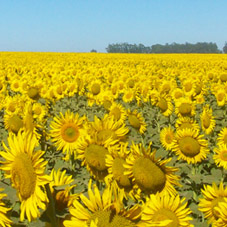Final stretch for the Argentine honey harvest 2021
February 24th, 2021
 Version en Castellano
Version en Castellano (Espacio Apícola, February 24th, 2021) A meager honey harvest in the "Pampa Húmeda" region in Argentina this year precisely due to lack of humidity. The drought caused by "La Niña" phenomenon, low temperatures on the equatorial line of the Pacific Ocean, affected mainly the province of Buenos Aires, Córdoba, South of Santa Fe, including Entre Ríos, even La Pampa and southwest of Córdoba which are areas generally not so affected by "La Niña" phenomenon.
(Espacio Apícola, February 24th, 2021) A meager honey harvest in the "Pampa Húmeda" region in Argentina this year precisely due to lack of humidity. The drought caused by "La Niña" phenomenon, low temperatures on the equatorial line of the Pacific Ocean, affected mainly the province of Buenos Aires, Córdoba, South of Santa Fe, including Entre Ríos, even La Pampa and southwest of Córdoba which are areas generally not so affected by "La Niña" phenomenon.January and February were rainy, with less insolation and lower temperatures than usual, which did not favor the late development of the meadows in the center of the country.
The best harvests have been in areas of natural dry forest this year, surpassing the historical averages for these ecosystems in Santiago del Estero, northwest of Córdoba, north of San Luis and north-central Santa Fe and Entre Ríos provinces (a natural forest area of more than 120.000 km2).
Sunflower cultivation has recovered a lot of ground in the cultivable plains of Argentina, which implies a significant increase in the production of honey from this oilseed (about 20,000 km2). In Buenos Aires province there were signs of water deficit and pollination failures were reported (according to ASAGIR's report). Sunflower is an important alternative for honey producers, although pollen contaminated with neonicotinoids from its treated seeds implies a serious risk in the post-honey harvest period for its impact on nurse bees and brood.
The rains of January and February have substantially improved the situation of Paraná River islands, from San Javier (Santa Fe) to the Lechiguanas Islands in front of Ramallo and San Pedro cities in Buenos Aires province (more than 500 km long and from 25 to 70 km wide area of islands following the river and its flooding areas), there the nectar flow is good currently.
Beekeepers from Entre Ríos and on the prairies where soybeans of short cycle have been seeding, particularly used after a dry spring, have faced many spraying events in full bloom, with the consequent loss of bees. Soy honey is the most important production in several Entre Ríos departments, such as Diamante, however, the contamination with glyphosate, the presence of transgenic pollen and the risks of fumigation show the inconvenience of their coexistence.
Eucalyptus is also blooming on the coast of the Uruguay River, to the north and south of Concordia city in Entre Ríos province. This area received a good contribution of rainfall so with good insolation and temperature a good performance is espected. In the southwest of Buenos Aires, where the season got off to a very good start, the drought prevailed and today they are waiting for it to rain in abundance so that the "flor amarilla" sprouts.
Information generated by "Espacio Apícola" the Argentine Beekeepers' Magazine apicultura.com.ar

